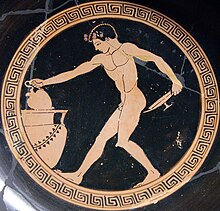History of wine
Despite the devastating 1887 phylloxera louse infestation, modern science and technology adapted and industrial wine production and widespread consumption now occur throughout the world.Greek mythology placed the childhood of Dionysus and his discovery of viticulture at Mount Nysa but had him teach the practice to the peoples of central Anatolia.Going to the king's warehouse, the woman sought out a jar marked "poison" containing the remnants of the grapes that had spoiled and were now deemed undrinkable.She took her discovery to the king, who became so enamored of his new drink that he not only accepted the woman back but also decreed that all grapes grown in Persepolis would be devoted to winemaking.[44] Production of beer had largely disappeared by the time of the Han dynasty, in favor of stronger drinks fermented from millet, rice, and other grains.During the 2nd century BC, Zhang Qian's exploration of the Western Regions (modern Xinjiang) reached the Hellenistic successor states of Alexander's empire: Dayuan, Bactria, and the Indo-Greek Kingdom.[43][45][46] Wine was imported again when trade with the west was restored under the Tang dynasty, but it remained mostly imperial fare and it was not until the Song that its consumption spread among the gentry.A thriving royal winemaking industry was established in the Nile Delta following the introduction of grape cultivation from the Levant to Egypt c. 3000 BC.The industry was most likely the result of trade between Egypt and Canaan during the early Bronze Age, commencing from at least the 27th-century BC Third Dynasty, the beginning of the Old Kingdom period.Archaeological findings, including charred grape seeds and occasionally intact berries or raisins, have been unearthed in numerous prehistoric and historic sites across Southwest Asia.Having deep historical roots dating back to at least the Bronze Age, winemaking in the Levant retained its importance as a significant regional industry until the decline of Byzantine rule in the 7th century CE.This prolonged history of winemaking significantly enriched the cultural and economic tapestry of ancient societies in the region, giving rise to numerous legends and beliefs intertwined with its consumption in the Mediterranean and Near East.The Israelite prophet Hosea (780–725 BC) is said to have urged his followers to return to Yahweh so that "they will blossom as the vine, [and] their fragrance will be like the wine of Lebanon".The Phoenicians also established colonies along the Mediterranean coasts, from modern-day Tunisia to Spain, where they introduced viticulture practices and grape cultivation.Following the fermentation process, the wine was meticulously stored in amphorae, often lined with protective resin coatings to ensure preservation.Jewish winemaking evolved during the Hellenistic period, with dried grapes producing sweeter, higher alcohol content wine that required dilution with water for consumption.[66] They introduced the V. vinifera vine to[67] and made wine in their numerous colonies in modern-day Italy,[68] Sicily,[69] southern France,[70] and Spain.[81] Pliny and others also named Vinum Hadrianum as one of the most rated wines, along with Praetutian from Ancona on the Adriatic, Mamertine from Messina in Sicily, Rhaetic from Verona, and a few others.[19] The oldest surviving urn of wine in liquid state was found in 2019 in a Roman mausoleum in Carmona, southern Spain, and is about 2000 years old.In 1435 Count John IV of Katzenelnbogen, a wealthy member of the high nobility of the Holy Roman Empire from near Frankfurt, was the first to plant Riesling, the most important German grape.A housewife of the merchant class or a servant in a noble household would have served wine at every meal, and had a selection of reds and whites alike.[60] Jofroi of Waterford, a 13th-century Dominican, wrote a catalogue of all the known wines and ales of Europe, describing them with great relish and recommending them to academics and counsellors.Rashi, a medieval French rabbi called the "father" of all subsequent commentaries on the Talmud and the Tanakh,[90] earned his living as a vintner.[92] Succeeding waves of immigrants, particularly in the 19th and early 20th centuries, imported French, Italian and German V. vinifera grapes, although wine from those native to the Americas (whose flavors can be distinctly different) is also produced.French-American hybrid grapes were developed and saw some use in Europe, but more important was the practice of grafting European grapevines to American rootstocks to protect vineyards from the insect.In California, the centre of viticulture shifted from the southern missions to the Central Valley and the northern counties of Sonoma, Napa, and Mendocino.In the late 19th century, the phylloxera louse brought widespread destruction to grapevines, wine production, and those whose livelihoods depended on them; far-reaching repercussions included the loss of many indigenous varieties.Cuvées were also standardized, important in creating certain wines as they are known today; Champagne and Bordeaux finally achieved the grape mixes that now define them.Australia's First Fleet (1788) brought cuttings of vines from South Africa, although initial plantings failed and the first successful vineyards were established in the early 19th century.







grapesNon-grape winePaphosDionysossymposiumGeorgiaGreeceArmeniaSicilyfermented alcoholic beveragealtered consciousnessconsidered religiousancient GreeksDionysusBacchusAncient Romansritual winepracticeBiblical timeseucharistLast Suppereven more essential to the Christian ChurchGolden Agealchemistspioneered wine's distillationmedicinalWine productionEuropean expansionphylloxerawritten recordsmodern archaeologygrapevinesGeorgianKvevriGeorgian National MuseumVitis vinifera subsp. sylvestrisV. viniferapotteryNeolithicHajj FiruzWest Azerbaijan provinceretsinaturpentinepine resinGreater IranGreek Macedoniawinery"Areni-1" caveVayots DzorPersian winesApadana PalacePersepolisNear EastBronze Ageetiological mythsBiblicalBook of GenesisGreat FloodGreek mythologyviticultureMount NysaAnatoliaPersianJamshidHistory of alcohol in ChinaHistory of wine in ChinaV. thunbergiiHan dynastymillethuangjiuZhang QianWestern RegionsXinjiangHellenisticsuccessor statesAlexanderempireDayuanBactriaIndo-Greek KingdomCentral AsiaTang dynastygentryMarco Polorice winesYuan Chinaancient EgyptianNile DeltaLevantCanaanThird DynastyOld KingdomShedehpomegranatesPlutarchMoraliaPsammetichus Ipharaohsoffer it to the godsamphorasTutankhamunwhite winePhoenicians and wineLebanese wineIsraeli wineSouthwest AsiaByzantinePhoenicianseastern MediterraneanIsraeliteYahwehLebanoncoloniesCarthagePunic Warspassumraisin wineancient Israelite cuisineancient IsraelJudaismGibeonHebrew BibleHebrew languageHellenistic periodLate AntiquityLevant was under Byzantine control
